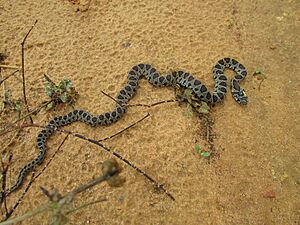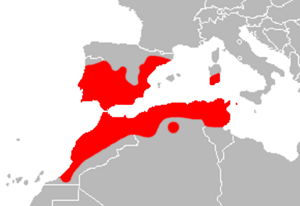Horseshoe whip snake facts for kids
Quick facts for kids Horseshoe whip snake |
|
|---|---|
 |
|
| Conservation status | |
| Scientific classification | |
| Genus: |
Hemorrhois
|
| Species: |
hippocrepis
|
 |
|
| Synonyms | |
The horseshoe whip snake (Hemorrhois hippocrepis) is a cool type of snake found in parts of Europe and North Africa. It gets its name from a special horseshoe-shaped mark on its head. This snake is known for being fast and can grow quite long!
Contents
What Does the Horseshoe Whip Snake Look Like?
Adult horseshoe whip snakes can grow up to about 1.5 meters (5 feet) long, including their tail. They have a slender body and a head that is wider than their neck. Their eyes are large with round pupils.
Their back scales are smooth and arranged in many rows. The snake's back usually has a series of large spots. These spots are often blackish or dark brown with black edges. There are also smaller dark spots along each side.
The color between the spots can be yellowish, olive, or reddish. The dark spots are close together. This makes the snake look dark with a lighter pattern that might remind you of a chain or a series of X's.
A special light-colored mark shaped like a horseshoe is found on its neck and the back of its head. This unique mark helps to identify the snake.
Where Do Horseshoe Whip Snakes Live?
Horseshoe whip snakes are found in southwestern Europe and northern Africa. In North Africa, you can find them in Algeria, Morocco, and Tunisia.
In Europe, they live in southern and central Portugal, and southern, eastern, and central Spain. They are also found in Gibraltar, southern Sardinia, and Pantelleria Island.
Sometimes, these snakes are introduced to new places by accident. Since the early 2000s, they have been seen on the Balearic Islands like Mallorca, Ibiza, and Formentera. They might have arrived there hidden in old olive trees brought from mainland Spain. On these islands, they seem to grow even larger than on the mainland!
What Kind of Places Do They Like?
Horseshoe whip snakes can live in many different environments. Their natural habitats include areas with Mediterranean-type shrubs and rocky places. They also like rocky and sandy shores.
You can find them in arable land (farms), pastures, and plantations. They are also comfortable living near people, often found in rural gardens and even urban areas. This shows they can adapt well to different surroundings.
Reproduction and Life Cycle
The horseshoe whip snake reproduces by laying eggs. This means they are oviparous. The female snake lays her eggs, and the young snakes hatch from these eggs later.
Types of Horseshoe Whip Snakes
Scientists recognize two main types, or subspecies, of the horseshoe whip snake:
- Hemorrhois hippocrepis hippocrepis (Linnaeus, 1758)
- Hemorrhois hippocrepis nigrescens (Cattaneo, 1985) (found on Pantelleria Island)
When you see a name like Hemorrhois hippocrepis hippocrepis with a name and year in parentheses, it means that this specific type of snake was first described under a different scientific group name.
How Are Horseshoe Whip Snakes Doing?
The horseshoe whip snake is currently listed as "Least Concern" by the International Union for Conservation of Nature. This means their population is stable, and they are not considered to be in danger of disappearing.
These snakes are good at adapting to changes in their habitat. However, they still face some challenges. They can be hit by cars on roads or poisoned by chemicals used in farming. Sometimes, they are also captured by people who use them for snake charming.
See also
- List of reptiles of Italy


